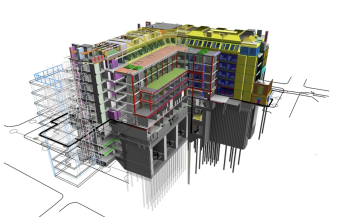In this second part of the article, Rafael Marin, student of the Master's in BIM Management, introduces some concepts about BIM data exchange between design actors and builders.
Introduction
We already know: BIM is, first of all, Information. I do not think it is necessary to return too much to the subject that BIM is, essentially, a large database or platform for the creation, storage, management and dissemination of information.
In our concrete case, it is information irremediably associated with 3D geometry located in a certain space. Bearing in mind that the fundamental value of BIM is Information, and BIM data exchange between actors will be a major issue to be considered in this work methodology.
"The fundamental value of BIM is, therefore, the Information, and that is why the BIM data exchange will be a major project issue".
BIM maturity levels
As we did in the first part, we turned to our British friends as a source of BIM wisdom and enlightenment. It was back in 2008, that Bew and Richards proposed a classification scale of BIM maturity, which we find included in the British standard PAS 1192-2: 2013. From this scale we can observe an interesting extension that includes, the work tools associated with each level of BIM maturity. The graph below obtained from the website of the "Chartered Institute of Building" and we use it to illustrate the progressive process of BIM maturity that will inevitably follow the entire AECO industry (desirably sooner rather than later):

As we can see, starting from Level 0, where we only work with CAD platforms that produce "drawings" and where the exchange of information occurs in a very rudimentary way, we will achieve, in ascending collaboration, Level 3.
There will be a total integration of the different intervening actors in the life cycle of the building, so that, ideally, all the work contributed by each one of them in all the phases, in an iterative way, will be incorporated to the BIM model of the asset and it will eventually complete it until the management in the operations phase. Each actor is present throughout the process, in a totally collaborative environment in which the model, centralized and probably hosted in the cloud, is enriched and at the same time nurtures the various BIM actors involved in the process.
In this way, if hypothetically we had already reached a level 3 maturity in BIM (the desired final goal), we would have an optimal state of interoperability. We would find an overview as explicitly reflected in the following graph, obtained from an interesting article from the ACCA software technical information blog, BibLus:

As we can see, the exchanges of information stop occurring in a one-on-one manner among actors, avoiding therefore, the consequent errors derived from delays in the release of information, the risk of not working in the most updated version, etc.
We would have a federated BIM model that acts as a repository for all the actors, in which they dump information and from which, analogously, they obtain it, always in real time (or almost).
The consequence of the collaboration: The Integrated Delivery of Project. IPD (Integrated Project Delivery)
"The Integrated Project Delivery (IPD) is a work methodology that generates a new type of collaborative relationship between the actors throughout the life cycle of the building. Level BIM maturity will make IPD a viable and realistic project partnership form.”
Without pretending to delve into all its depth, because the legal, technical and especially cultural derivations involved in the Integrated Project Delivery are broad and sometimes confusing, we will outline that the IPD, promoted by the American Institute of Architects, in collaboration with Building Smart International, is an essentially integrative work methodology, which generates a new type of collaborative relationship between the actors throughout the life cycle of the building.
This promotes, "the integration between people, systems, business structures and practices within a process that collaboratively leverages the talents and visions of all participants to optimize project results, increase value for the owner, reduce waste, and maximize efficiency across all phases of the project. design, manufacturing and construction starting from the early design and continuing up to the delivery in hand of the project".
Obviously, BIM Maturity Level 3 is, in essence, what will make IPD a viable and realistic form of project partnership.

Considering the relevant advantages that the IPD will have, it is no less true that the construction industry in Spain is still not, for the most part, prepared for this type of contracting of a relational nature, opting mainly for Design-Bid-Type contracts. Build (DBB) or Design-Contracting-Construction, that is, translational, in which each actor has a phase associated with the life cycle, and as his intervention ends, he withdraws from the process.
This, as we know, is a common source of delays, lack of communication and, in many cases, it takes a painful waste of time and money to rework the project information itself by the new agents that are incorporated into the process.
The "state of the art" in Spain and how to get the most out of BIM
Now we would be in a BIM maturity environment that, I value, would be placed, at best, between the states of Level 1 and Level 2.
However, in this evolution, it would be unfair not to recognize the effort made by all the professionals of Architecture, Engineering, Construction and Operations (AECO, for its acronym in English) to raise the levels of collaboration and get the most out to the investment made in adopting BIM methodologies and processes in our organizations.
So, how would it be possible to establish a series of work methods to take full advantage of incorporating BIM into a project?
The answer is complex and extensive, and will most certainly depend on the specific actors and the project. However, we can venture some specific points that I would take into account when designing, agreeing and establishing the Project BIM Execution Plan (BEP), a document of the utmost importance.
In addition, we cannot stop looking at the interesting reference provided by the uBIM guides of the association buildingSMART Spanish Chapter, and more specifically, Document D13 - Construction:

1. The level of development of the BIM model (LOD)
The level of development (Level of Development, or LOD) of the model that we will receive from the design team will greatly influence the possibilities and the benefits that we can draw from it. Although as a construction company, with a good BIM department, we can develop the model as much as we would like, it does not seem too logical considering the amount of resources, time and money that this task consumes, especially if we take into account the large amount of modifications that could occur during the construction phase, derived from a multitude of factors.
Thus, we will study for what uses it is viable to use the BIM model of the project, with its corresponding LOD: 3D coordination to avoid interferences, planning and temporary simulation of the development of work (4D), quantity takeoff and budgets (5D), visualizations of the state of work , etc.

On occasion, the client is already requesting BIM models for the management of the built asset, in bids based on CAD-based executive projects. In this case, the BEP and the corresponding agreements for the development of the BIM model and uses between constructor-property will take on as much or more importance than in the previous case.
2. The ownership and authorship of the BIM model 'issued for construction'
Although we, as a construction company, have been able to adapt the BIM model received during the tender and bidding phase for "internal use", we must not forget that, according to the LOE: "The construction manager is the agent who directs the development of the work in the technical, aesthetic, urban and environmental aspects, in accordance with the project that defines it, the building license and other mandatory authorizations and the conditions of the contract, in order to ensure its adequacy to the proposed purpose " Therefore, the only actor that will declare a BIM model "issued for construction" is the Construction Manager.
3. The exchange frequency of the 'issued for construction' model
We must ensure, of course, in the BEP, that BIM information is shared among actors with at least on a weekly basis. This exchange will be done both in native format and in a universal exchange standard (IFC). In addition to the model, the delivery of the associated planimetry and a report of changes produced in the model will be established from the previous update (detailed below).
4. What platform to use for BIM data exchange
There are many ways to share the package formed by the model (BIM and IFC), plans and modifications report. Among them are email, applications that work in the cloud, etc. However, personally, I prefer to use the FTP or File Transfer Protocol, which is the most reliable and most secure. It guarantees privacy and is capable of transmitting large amounts of information and almost instantaneously.
5. Modifications during construction
Simultaneously with the update of the BIM model, a report of modifications will be sent, which includes all the changes made to the model. They will be recorded in the specifications and will be published together with the model and plans. Although I am personally very much in favor of the BCF (BIM Collaboration Format) communication, we will leave this system for when we are evolving as a BIM constructor.
At this point, I find it very interesting to introduce the concept of element ID. Each element that is present in our model should have a unique identification key (or ID). It will be unique and unmistakable, so that it can be referenced to identify, in the modification report, if that element has undergone modifications, has been deleted, displaced, etc. This element ID will remain common and unalterable throughout the BIM life cycle of the building, thus, there will never be any doubts about which element or specific elements we are referring to at any time.

6. Model "as built"
The client is responsible for the design, but the contractor must present the construction data "as built" to the designers, who will collect and enrich the model -without another type of agreement established in the BEP-. Keeping the discipline (actually, contractually established) of the weekly exchange system and clear references to the elements, the creation of the "final work" goes from being the nuisance that has traditionally been, to a task that will take only a few minutes.
Do not forget to take into account that each project and each organization are worlds apart, and that therefore the exposed here are not but general recommendations. As always, my intention does not go beyond mere disclosure and pretension that its reading is pleasant and useful for both beginners and newcomers in the BIM world.


 As we can see, starting from Level 0, where we only work with CAD platforms that produce "drawings" and where the exchange of information occurs in a very rudimentary way, we will achieve, in ascending collaboration, Level 3.
There will be a total integration of the different intervening actors in the life cycle of the building, so that, ideally, all the work contributed by each one of them in all the phases, in an iterative way, will be incorporated to the BIM model of the asset and it will eventually complete it until the management in the operations phase. Each actor is present throughout the process, in a totally collaborative environment in which the model, centralized and probably hosted in the cloud, is enriched and at the same time nurtures the various BIM actors involved in the process.
In this way, if hypothetically we had already reached a level 3 maturity in BIM (the desired final goal), we would have an optimal state of interoperability. We would find an overview as explicitly reflected in the following graph, obtained from an interesting article from the ACCA software technical information blog, BibLus:
As we can see, starting from Level 0, where we only work with CAD platforms that produce "drawings" and where the exchange of information occurs in a very rudimentary way, we will achieve, in ascending collaboration, Level 3.
There will be a total integration of the different intervening actors in the life cycle of the building, so that, ideally, all the work contributed by each one of them in all the phases, in an iterative way, will be incorporated to the BIM model of the asset and it will eventually complete it until the management in the operations phase. Each actor is present throughout the process, in a totally collaborative environment in which the model, centralized and probably hosted in the cloud, is enriched and at the same time nurtures the various BIM actors involved in the process.
In this way, if hypothetically we had already reached a level 3 maturity in BIM (the desired final goal), we would have an optimal state of interoperability. We would find an overview as explicitly reflected in the following graph, obtained from an interesting article from the ACCA software technical information blog, BibLus:
 As we can see, the exchanges of information stop occurring in a one-on-one manner among actors, avoiding therefore, the consequent errors derived from delays in the release of information, the risk of not working in the most updated version, etc.
We would have a federated BIM model that acts as a repository for all the actors, in which they dump information and from which, analogously, they obtain it, always in real time (or almost).
As we can see, the exchanges of information stop occurring in a one-on-one manner among actors, avoiding therefore, the consequent errors derived from delays in the release of information, the risk of not working in the most updated version, etc.
We would have a federated BIM model that acts as a repository for all the actors, in which they dump information and from which, analogously, they obtain it, always in real time (or almost).
 Considering the relevant advantages that the IPD will have, it is no less true that the construction industry in Spain is still not, for the most part, prepared for this type of contracting of a relational nature, opting mainly for Design-Bid-Type contracts. Build (DBB) or Design-Contracting-Construction, that is, translational, in which each actor has a phase associated with the life cycle, and as his intervention ends, he withdraws from the process.
This, as we know, is a common source of delays, lack of communication and, in many cases, it takes a painful waste of time and money to rework the project information itself by the new agents that are incorporated into the process.
Considering the relevant advantages that the IPD will have, it is no less true that the construction industry in Spain is still not, for the most part, prepared for this type of contracting of a relational nature, opting mainly for Design-Bid-Type contracts. Build (DBB) or Design-Contracting-Construction, that is, translational, in which each actor has a phase associated with the life cycle, and as his intervention ends, he withdraws from the process.
This, as we know, is a common source of delays, lack of communication and, in many cases, it takes a painful waste of time and money to rework the project information itself by the new agents that are incorporated into the process.

 On occasion, the client is already requesting BIM models for the management of the built asset, in bids based on CAD-based executive projects. In this case, the BEP and the corresponding agreements for the development of the BIM model and uses between constructor-property will take on as much or more importance than in the previous case.
On occasion, the client is already requesting BIM models for the management of the built asset, in bids based on CAD-based executive projects. In this case, the BEP and the corresponding agreements for the development of the BIM model and uses between constructor-property will take on as much or more importance than in the previous case.





